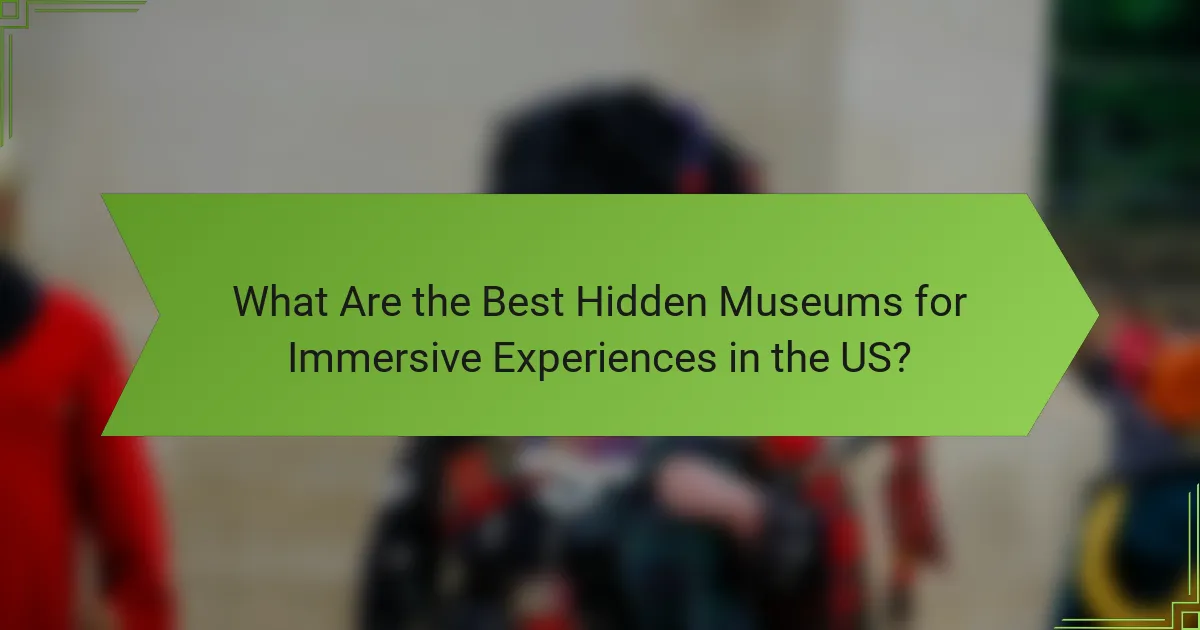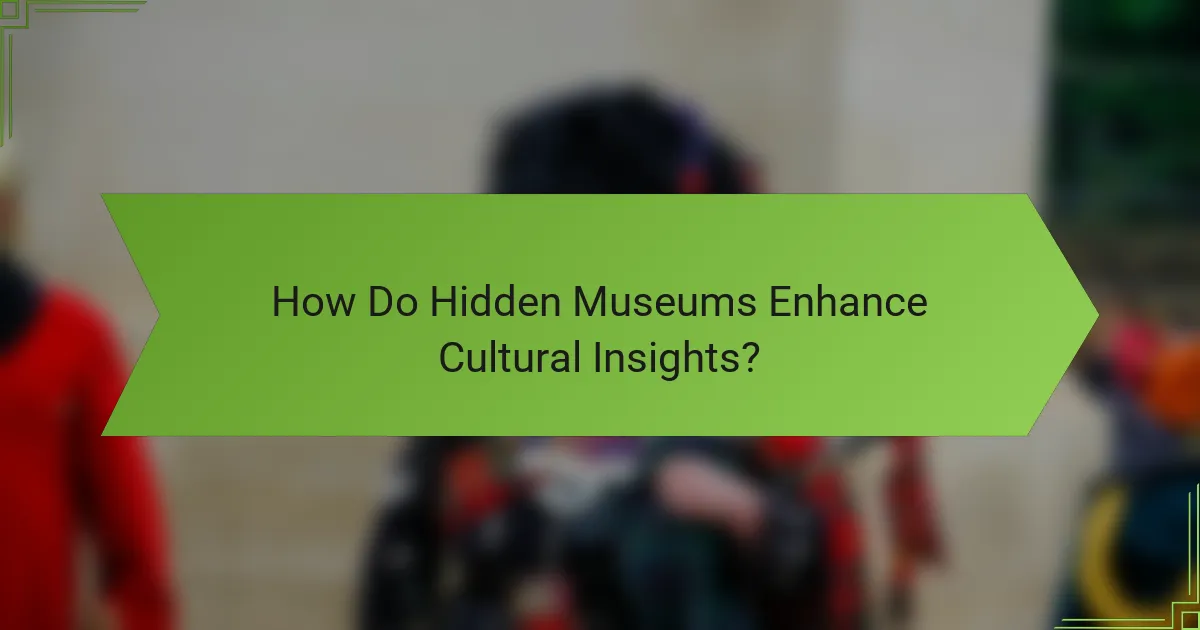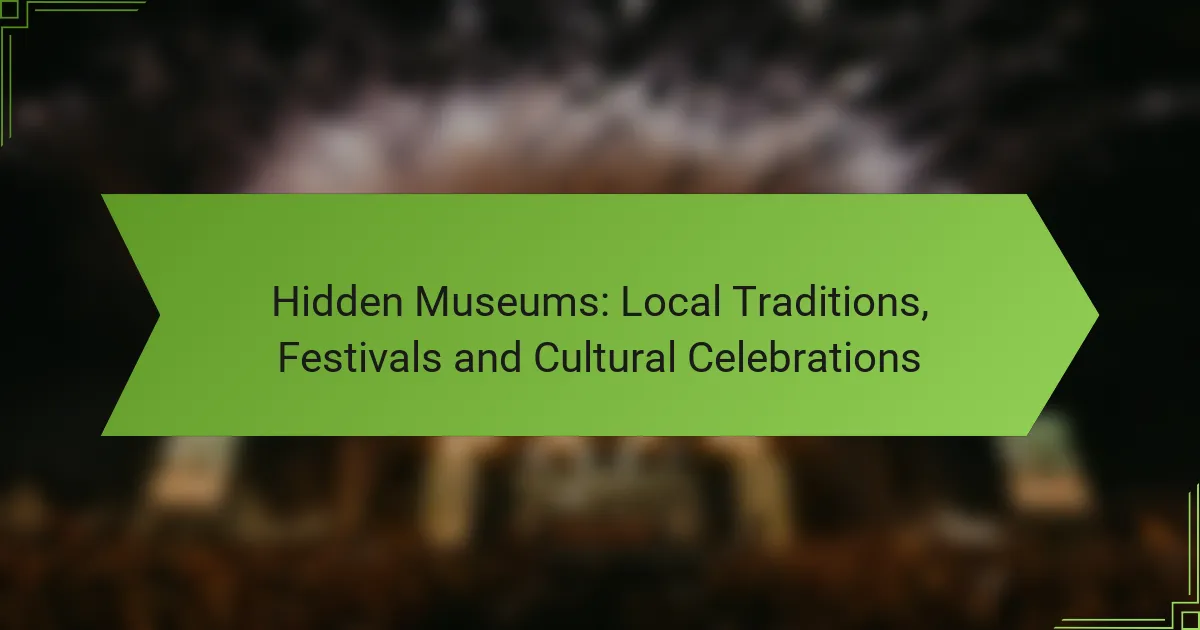Hidden museums across the US offer immersive experiences that invite visitors to engage with unique exhibits and artifacts, often centered around niche themes. These venues provide valuable cultural insights, showcasing local history and traditions that are frequently overlooked by larger institutions. By highlighting diverse collections and interactive installations, hidden museums create a deeper understanding of the cultures they represent.

What Are the Best Hidden Museums for Immersive Experiences in the US?
The best hidden museums for immersive experiences in the US offer unique, engaging environments that encourage visitors to interact with exhibits in meaningful ways. These museums often focus on niche themes, providing cultural insights and artifacts that are not typically found in larger institutions.
The Museum of Jurassic Technology
The Museum of Jurassic Technology in Los Angeles blends art, science, and history in an unconventional way. Visitors encounter a collection of exhibits that range from the bizarre to the whimsical, including miniature dioramas and obscure scientific artifacts.
This museum encourages exploration and curiosity, making it an ideal destination for those seeking a unique experience. Expect to spend at least an hour wandering through its dimly lit halls, where each exhibit invites contemplation and discovery.
The Magic Castle
Located in Hollywood, The Magic Castle is a private club for magicians and magic enthusiasts, but it also welcomes guests for immersive performances. Visitors can enjoy magic shows in various themed rooms, each offering a different atmosphere and style of performance.
To visit, you must secure an invitation from a member or book a dinner reservation. The experience is enhanced by the castle’s Victorian architecture and the opportunity to interact with performing magicians, making it a memorable evening.
The Tenement Museum
The Tenement Museum in New York City focuses on the immigrant experience in America through the lens of a restored tenement building. Guided tours take visitors through the apartments of past residents, showcasing their stories and the challenges they faced.
This museum emphasizes storytelling and personal narratives, providing a deep cultural insight into the lives of immigrants. Tours typically last around an hour and are available in various formats, including family-friendly options.
The Museum of Broken Relationships
Located in Los Angeles, The Museum of Broken Relationships features artifacts and stories from failed relationships, creating a poignant and relatable experience. Each item on display is accompanied by a narrative that explains its significance, allowing visitors to connect emotionally with the exhibits.
This museum invites reflection on love and loss, making it a unique venue for those interested in human experiences. Expect to spend about an hour exploring the exhibits, which often provoke thoughtful discussions among visitors.
The Spy Museum
The Spy Museum in Washington, D.C. offers an interactive experience centered on the world of espionage. Visitors can engage with various exhibits that showcase spy gadgets, undercover operations, and the history of espionage throughout the ages.
With hands-on activities and immersive experiences, such as simulating a spy mission, this museum is ideal for families and individuals interested in the thrill of espionage. Plan to spend at least two hours to fully appreciate the diverse exhibits and interactive elements.

How Do Hidden Museums Enhance Cultural Insights?
Hidden museums enhance cultural insights by offering immersive experiences that connect visitors with local history, art, and traditions. These venues often showcase unique artifacts and stories that are overlooked in larger, mainstream institutions, providing a deeper understanding of the culture they represent.
Interactive Exhibits
Interactive exhibits in hidden museums engage visitors by allowing them to participate actively in the learning process. For example, visitors might handle replicas of ancient tools or engage in traditional crafts, making the experience more memorable and impactful. This hands-on approach fosters a personal connection to the cultural narratives being presented.
Many hidden museums utilize technology, such as augmented reality, to enhance interactivity. This can include virtual tours or interactive displays that provide additional context about artifacts, enriching the visitor experience.
Local Community Involvement
Local community involvement is crucial for hidden museums, as it ensures that the exhibits reflect authentic cultural narratives. Many of these museums collaborate with local artists and historians to curate their collections, which helps preserve and promote regional heritage. This partnership not only supports the community but also enriches the museum’s offerings.
Additionally, hidden museums often host community events, workshops, and lectures that encourage local participation. These activities create a sense of ownership among residents and foster a deeper appreciation for their cultural heritage.
Unique Storytelling Techniques
Hidden museums often employ unique storytelling techniques to convey cultural insights effectively. By using personal narratives, oral histories, and multimedia presentations, they create a more engaging and relatable experience for visitors. This approach allows for a diverse range of perspectives, making the stories more inclusive.
For instance, a hidden museum might feature audio recordings of local elders sharing their experiences, which adds emotional depth to the exhibits. Such storytelling methods not only educate but also evoke empathy, helping visitors connect with the culture on a personal level.

What Artifacts Are Commonly Found in Hidden Museums?
Hidden museums often showcase a diverse range of artifacts that provide unique insights into culture, history, and art. These artifacts can vary widely, but they typically include historical items, unique collections, and interactive installations that engage visitors in immersive experiences.
Historical Artifacts
Historical artifacts in hidden museums often include items like ancient tools, manuscripts, and personal belongings of notable figures. These objects help to tell the story of a particular time or place, offering visitors a tangible connection to the past.
For example, you might find a collection of medieval coins or a rare first edition of a significant literary work. Such artifacts are not only valuable for their historical significance but also for the insights they provide into the daily lives and cultures of people from different eras.
Unique Collections
Unique collections in hidden museums can encompass a wide array of themes, from quirky memorabilia to specialized art pieces. These collections often reflect the personal interests of the curators or the local culture, making them distinct from larger, more mainstream institutions.
Examples include collections of vintage toys, local artisan crafts, or even unusual taxidermy. Visitors are often drawn to these unique items because they offer a glimpse into niche aspects of culture that are not commonly represented in larger museums.
Interactive Installations
Interactive installations are a hallmark of many hidden museums, designed to engage visitors in a hands-on manner. These installations can include virtual reality experiences, touchable exhibits, or participatory art projects that invite guests to contribute.
For instance, some museums might feature a digital display where visitors can create their own art or a sensory room that allows for exploration through sound and light. These experiences not only enhance learning but also make the visit more memorable and enjoyable.

How to Find Hidden Museums Near You?
To discover hidden museums in your area, start by exploring local resources and online platforms that specialize in lesser-known cultural sites. These museums often offer unique experiences and insights into local history and art that mainstream venues may overlook.
Online Resources
Utilize websites dedicated to cultural tourism and hidden gems, such as Atlas Obscura or local tourism boards. These platforms often feature user-generated content, reviews, and detailed descriptions of off-the-beaten-path museums.
Additionally, consider using Google Maps to search for museums in your vicinity. Filtering results by ratings and reviews can help you identify lesser-known spots that may not appear in traditional listings.
Local Guides
Consult local guidebooks or city-specific travel blogs that focus on unique attractions. Many cities have publications that highlight hidden cultural sites, providing insights into their history and significance.
Engaging with local historians or cultural organizations can also yield valuable recommendations. They often have insider knowledge about small, community-run museums that are not widely advertised.
Social Media Recommendations
Platforms like Instagram and Facebook can be excellent resources for discovering hidden museums. Search for hashtags related to your city or specific interests, such as #HiddenMuseums or #LocalArt.
Join local community groups or forums where residents share their favorite spots. These recommendations can lead you to unique experiences that may not be found in conventional travel guides.

What Are the Benefits of Visiting Hidden Museums?
Visiting hidden museums offers unique benefits, including personalized experiences and deeper cultural insights. These lesser-known venues often feature exclusive artifacts and immersive exhibits that enhance understanding of local history and art.
Personalized Experiences
Hidden museums frequently provide more personalized experiences compared to larger institutions. With smaller visitor numbers, staff can offer tailored tours and engage in meaningful conversations about the exhibits. This intimate setting allows for a deeper connection to the art and culture presented.
Consider visiting during off-peak hours or scheduling a private tour to maximize your experience. Many hidden museums are open to customization, allowing you to focus on specific interests, whether it’s local history, contemporary art, or unique artifacts.
When planning your visit, check if the museum offers workshops or interactive sessions. These activities can provide hands-on experiences that enhance your understanding and appreciation of the exhibits, making your visit more memorable.



